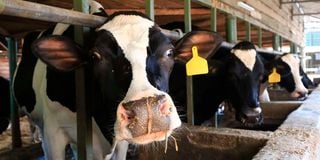Premium
Antimicrobial resistance: We all have a role to play

Dairy cows at Meved dairy farm at Rukanga in Kirinyaga County on December 28, 2021.
Livestock farming has a key role in preventing development of antimicrobial resistance. The World Antimicrobial Resistance Awareness Week (WAAW) ran from November 18 to 24. It is celebrated with various activities but has one theme.
This year’s theme is the same as for 2022; “Preventing Antimicrobial Resistance Together”.
The question, however, arises as to whom “together” refers. It is all people and institutions concerned with the production, use and regulation of antimicrobials.
I recall discussing antimicrobial resistance with a farmer and she asked me if I meant antibiotic resistance.
Antibiotic resistance refers to the ability of bacteria to continue thriving in the presence of antibiotics. This is a small group of drugs used to control or kill bacteria.
Antimicrobial resistance or AMR refers to the ability of any disease-causing organism or microbe to continue thriving when exposed to chemicals used to treat the disease it causes.
The term antimicrobials refers to the class of chemicals used to treat or prevent diseases caused by bacteria, viruses, some parasites like those for malaria and fungi. An antibiotic, therefore, is a form of an antimicrobial.
Livestock farming has been identified as one of the major contributors to the development of AMR in humans, animals and the environment.
Efforts are being employed globally to minimise AMR development emanating from farming.
Did you know that many of the infectious diseases found in livestock are able to also infect humans through food or the environment? AMR in livestock complicates the treatment of some diseases in humans.
Furthermore, micro-organisms with AMR in animals may contaminate the environment, reproduce with similar micro-organisms affecting humans and transmit the AMR genes to their new generations. Humans may then get infected with the AMR organisms from the environment.
Livestock farming is vulnerable to the development of AMR because of the magnitude of the animal resources industry and its close relationship with humans. Scientists estimate AMR could cause up to 10 million human deaths and losses of $100 trillion by 2050, if measures are not taken to prevent its development.
To control AMR development, we must first understand how it evolves. Micro-organisms, like all other living things, have the urge to propagate their species. They are able to identify environmental factors that can lead to their extermination.
Once microbes are exposed to chemicals that can kill them, they either die very quickly or are injured to a degree that allows them to heal and continue thriving.
The most suitable antimicrobial is one that kills microbes at low concentration and fast.
However, due to a variety of factors, a single application of an antimicrobial may not kill all the microbes, thereby presenting an opportunity for AMR development.
That is the reason most antimicrobial treatments are given for a course of at least three days and a dose after every six to 12 hours.
The idea is to present the disease microbes no opportunity to recover from the initial dose and start developing AMR.
The most common causes of AMR development are human errors and the ability of some microbes to quickly develop antimicrobial defence mechanisms.
There are microbes that rapidly develop the ability to produce chemicals that break down antimicrobials before they act.
This is for instance one of the reasons that penicillin-based antibiotics are not able to treat mastitis in cattle and pneumonia in humans.
Microbes have also been shown to develop systems to pump out antimicrobial molecules from inside their cells and prevent them from destroying the microbes’ genetic material.
Some microbes also modify their cell walls and prevent the antimicrobial molecules from entering the cells.
AMR develops a lot where drugs have been improperly used and where humans are exposed to small quantities of drugs in the environment or food.
This is where livestock farming becomes a major contributor to development of AMR.
A major pathway for inducing AMR in humans through food is the failure of farmers and livestock health practitioners to observe the food withholding periods for milk, meat and eggs.
Whenever animals are treated with antimicrobials, their milk, meat or eggs should not be consumed by humans for a stipulated period of time mostly up to 28 days, depending on the antimicrobial used.
It is the role of the livestock product regulator to publish withholding periods for every product and the manufacturer to indicate it on the product label.
The livestock health service provider should detail the farmer on the withholding period while the farmer must ensure they comply.
The processor of foods of animal origin should confirm with the farmer that any animal or product destined for human food is confirmed not to be within a withholding period.
Finally, human food regulators should ensure random sampling of foods of animal origin and analyse them for antimicrobial residues to protect humans from consuming small quantities of antimicrobials that would encourage the development of AMR.
In addition to observing withholding periods, livestock health practitioners should assist farmers to minimise the use of antimicrobials by embracing stringent disease prevention measures.
These include vaccination for all diseases that may be prevented with vaccines, good hygiene and biosecurity, good livestock nutrition and management, breeding of animals with high resistance to specific diseases; among other measures.





